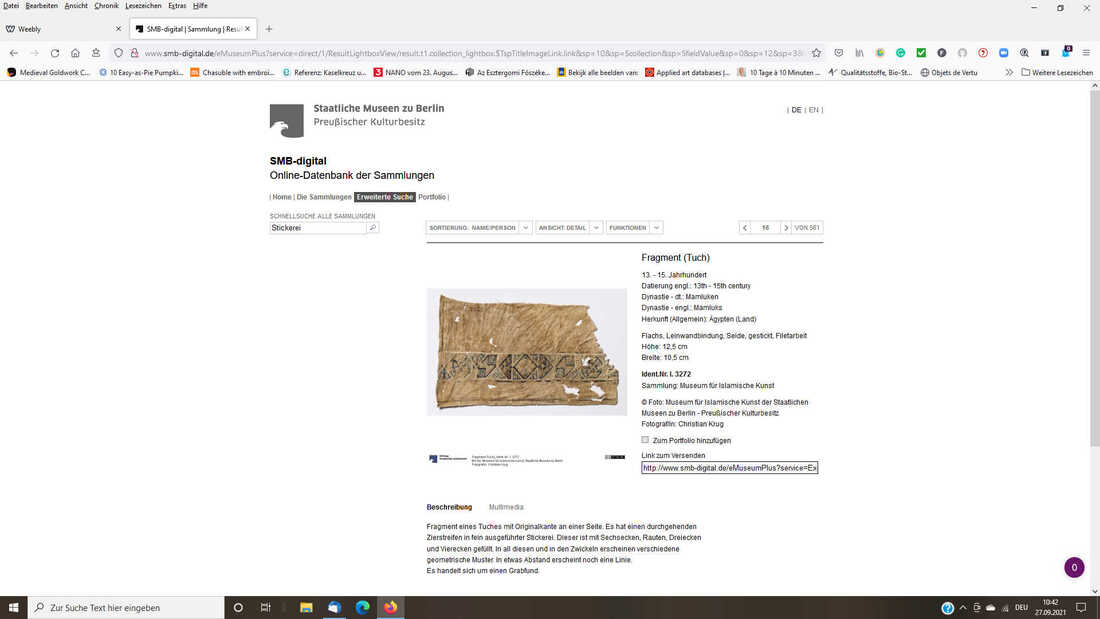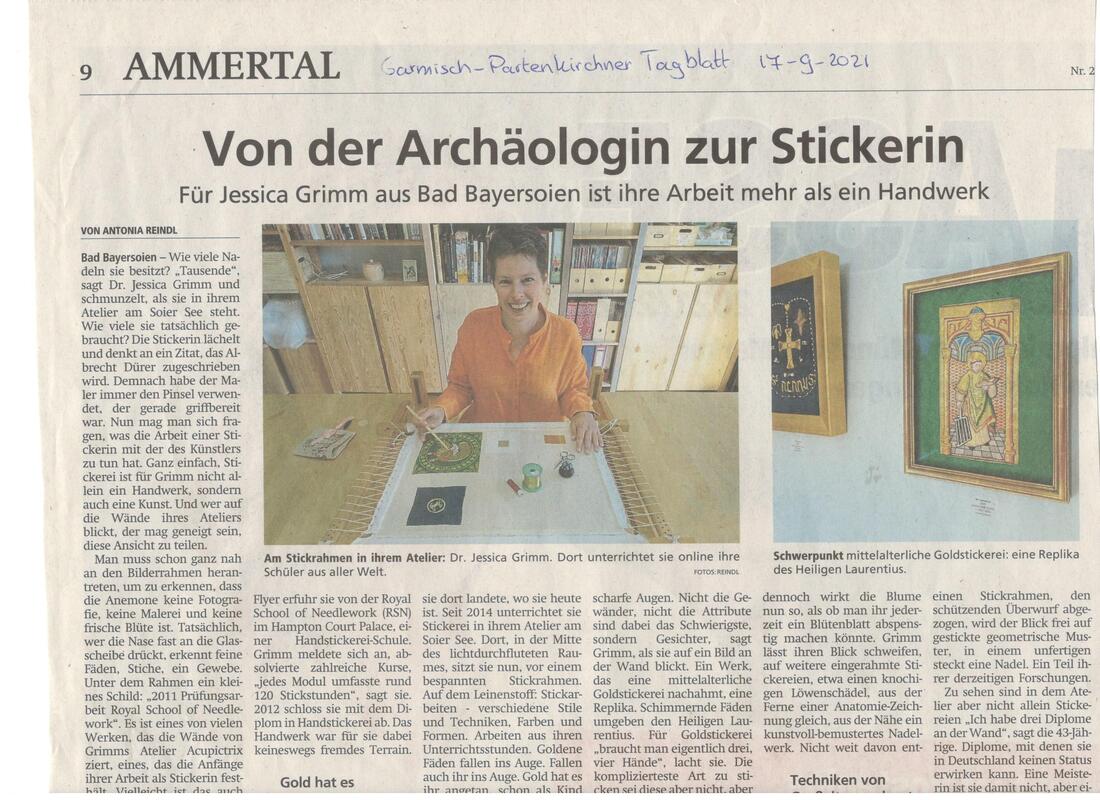|
Today, I am going to introduce you to a fantastic online museum catalogue: the online collection of the Staatliche Museen zu Berlin. You'll have access to the digital collection of the many important museums in Berlin, Germany. And although not all embroidered pieces have been digitized yet, there are hundreds of gems to be discovered. Whether you like whitework or folk embroidery. Although the website can be changed to English, searching in German gets you the better results. So below are a few screenshots of what you should enter where for best results. If you follow the link to the online catalogue, this is what the entry page looks like. Now fill in "Stickerei" in the search box and click the little magnifier. You'll now see the first 12 entries with pictures of a total of 561 embroidered objects in the museum collection. You can use the little arrows to navigate through the many pages with results. Clicking on a picture provides you with detailed information on a particular object. Changing the language to English unfortunately doesn't help. If you click again on the picture it will enlarge. However, if you would like a really good picture with high-resolution, click on the Multimedia tab below the picture and then click on the picture that appears.
Enjoy!
8 Comments
Today's local newspaper contains a lovely grown-up story about my embroideries, my research and my art. Enjoy! As the piece is just a little bigger than my scanner, the header was chopped off. Below is the header with the name of the newspaper and the excellent journalist.
Before I'll provide you with some incredible eye candy, let us return to last week's blog post. Some of you wrote to tell that they were sorry to see another embroidery shop close. A few were even dismayed as it now meant that it was even harder for them to source materials. Please know that it wasn't an easy choice for me to start selling off my stock. Precisely because high-end embroidery materials are harder and harder to find, I had always hoped that I could make a success of my webshop/brick-and-mortar shop. Alas, it never happened. Before the pandemic, I had about five visitors a year. I never managed to become a needlework destination where you could both buy gorgeous threads and feast your eyes on pretty spectacular embroideries. Being located in a National Park with many places to visit, one would think that my shop and atelier had everything going for it. But it didn't. And even now, with a 50% discount on most goods things aren't exactly flying off the shelves. This has proven to me, that although a bit painful, closing my shop is the right thing to do. Onto greener pastures! At the beginning of the month, my husband and I made a day trip to Salzburg in Austria. We visited the various church museums and saw many spectacular pieces of ecclesiastical art. And although hardly any embroidery was on display, the Museum St. Peter had an amazing chasuble cross on display. As you are not allowed to take pictures of it, I was lucky to find a couple of detailed pictures on a website for tenders.
As you can see from the above picture, this is not your average piece of stumpwork or raised embroidery! The figure of Christ is nearly fully three-dimensional. He really is a textile sculpture. And although those of you familiar with 17th-century stumpwork from England will see some similar techniques and threads, the main figure of Christ was made in a technique not seen in these 17th-century pieces. He was made in a mould. Built-up with linen scraps soaked in glue and stuffed with pieces crafted from wood and leather. Although "minor" padding can be seen in medieval goldwork embroidery from quite early on, these very three-dimensional pieces were made in the South of Germany, Austria and Hungary during a short period of time. As a group, they are so far not really systematically studied and the academic literature is older and patchy. This seems to be due to the fact that they are an 'in-between': not seen as sculpture, but not quite normal embroidery either. And some people have an aversion to these pieces as they look a bit like the priest has a dolls house on his back ... (just like with those elaborately decorated skeletons of saints, these textile pieces end up in the attic and are forgotten about!). Wouldn't it be cool to gather a group of interdisciplinary academic researchers and start a research project? Have each piece go through a scanner to see which materials are hiding beneath the outer layers of silk and embroidery? Just like those Egyptian mummies projects! So far, there does not seem to be much interest from those who research the later 17th-century stumpwork embroidery from England. This is likely due to the language barrier. Equally, those 17th-century pieces are not mentioned in the literature on these 15th- and 16th-century pieces. Are both traditions independent of each other or can we find a continuous line of development? By publishing this short introduction on my blog, I hope to alert people to the existence of these amazing textile sculptures! |
Want to keep up with my embroidery adventures? Sign up for my weekly Newsletter to get notified of new blogs, courses and workshops!
Liked my blog? Please consider making a donation or becoming a Patron so that I can keep up the good work and my blog ad-free!
Categories
All
Archives
July 2024
|
Contact: info(at)jessicagrimm.com
Copyright Dr Jessica M. Grimm - Mandlweg 3, 82488 Ettal, Deutschland - +49(0)8822 2782219 (Monday, Tuesday, Friday & Saturday 9.00-17.00 CET)
Impressum - Legal Notice - Datenschutzerklärung - Privacy Policy - Webshop ABG - Widerrufsrecht - Disclaimer
Copyright Dr Jessica M. Grimm - Mandlweg 3, 82488 Ettal, Deutschland - +49(0)8822 2782219 (Monday, Tuesday, Friday & Saturday 9.00-17.00 CET)
Impressum - Legal Notice - Datenschutzerklärung - Privacy Policy - Webshop ABG - Widerrufsrecht - Disclaimer















 RSS Feed
RSS Feed